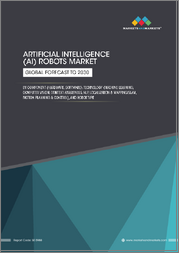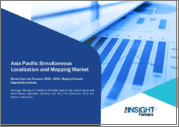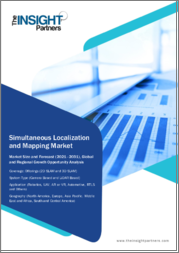
|
시장보고서
상품코드
1415520
이미징 용도에서 SLAM 기술의 성장 기회 분석 분석Growth Opportunity Analysis of SLAM Technology in Imaging Applications |
||||||
매핑, 측량, 위치 기반 서비스 및 애플리케이션이 산업을 변화시킬 것입니다.
이미지 용도의 SLAM(Simultaneous Localization and Mapping) 기술은 센서 기술과 소프트웨어 알고리즘에 의존하여 자율주행차, 로봇, 드론과 같은 자율 시스템이 동시에 주변 지도를 작성하고, 탐색하고, 효율적으로 조작하고, 지도상에서 위치를 추정할 수 있게 해줍니다. SLAM은 관성 측정 장치, 카메라 시스템, LiDAR를 활용하여 주변 환경의 데이터를 수집합니다. SLAM 알고리즘은 센서 데이터를 분석하여 환경 지도를 작성하고 위치 및 방향 파라미터를 추정합니다. 이 알고리즘은 복잡하고 계산 비용이 많이 들지만 최근 수십년동안 크게 발전했습니다.
SLAM은 로봇, 증강현실(AR), 가상현실(VR), 자율주행차 등 다양한 영상 처리 용도에 필수적인 기술로, 시장이 빠르게 성장하고 있습니다. 도시 계획가, 건설 관리자 및 측량사는 SLAM을 통해 대규모 경관의 3D 지도를 쉽고 원하는 정확도로 제작할 수 있습니다.
본 조사의 내용
- 이미징 용도에서의 SLAM 기술 개요
- 영상 용도에서의 SLAM 알고리즘의 유형
- 영상처리 용도에서의 SLAM 알고리즘 비교 분석
- SLAM 기반 이미징 시스템에서 센서 융합의 영향과 의의
- 의료영상, 위성, 로봇, AR/VR 용도에서 SLAM 기술의 영향력 분석
- 산업별 SLAM 기술의 새로운 활용 사례
- 주요 성장 기회, 비즈니스 모델 및 미래 방향성
목차
전략적 과제
- 왜 성장이 어려워지고 있는가?
- The Strategic Imperative 8(TM)
- 동시정위 지도제작(SLAM) 업계에 대한 상위 3개 전략적 과제의 영향
- 성장 기회가 Growth Pipeline Engine(TM)
- 조사 방법
- 성장 환경
- 기술 매력 대시보드
성장 기회 분석
- 분석 범위
- 영상 용도용 SLAM 알고리즘 세분화
- 성장 촉진요인
- 성장 억제요인
기술 상황 평가
- 이미징 용도 SLAM 기술 개요
- 이미징 용도 SLAM 알고리즘의 유형
- 다양한 SLAM 알고리즘의 장단점
- 이미징 용도에 SLAM 알고리즘을 선택할 때의 고려 요소
- 영상 처리 용도 용SLAM 알고리즘 비교 분석
- SLAM을 위한 센서 퓨전
- SLAM 성능 평가 지표 - 준비, 평가, 테스트 단계
- 특허 연구 중점 분야
- 펀딩 거래 및 중점 분야
다양한 산업 분야의 이미징 애플리케이션을 위한 SLAM 기술의 영향 분석
- 위성 및 의료 영상 애플리케이션을 위한 SLAM 기술의 영향 분석
- 새로운 사용 사례 - 위성 및 의료 영상용 SLAM 기술
- 로보틱스 애플리케이션을 위한 SLAM 기술
- 로보틱스 애플리케이션을 위한 SLAM 기술의 영향 분석
- 새로운 사용 사례 - 로봇 공학용 SLAM 기술
- AR/VR 애플리케이션을 위한 SLAM 기술
- AR/VR 애플리케이션을 위한 SLAM 기술의 영향 분석
- 새로운 사용 사례 - AR/VR을 위한 SLAM 기술
- SLAM 기술의 지역별 동향 및 영향
- 주요 이해관계자 및 신생 스타트업의 주요 기술 개발 현황
- 이미징 애플리케이션에서 SLAM 기술의 다양한 비즈니스 모델
- SLAM R&D의 미래 방향
성장 기회
- 성장 기회 1 : 멀티센서 퓨전 SLAM 시스템
- 성장 기회 2 : 자율 산업용 로봇
- 성장 기회 3 : UAV
부록
- 기술 성숙도(TRL) : 설명
다음 단계
- 다음 단계
- 왜 Frost인가? 왜 지금인가?
- 면책사항
Mapping, Surveying, and Location-based Services and Applications are Transforming the Industry
Simultaneous localization and mapping (SLAM) technology in imaging applications is relying on sensor technologies and software algorithms. SLAM allows autonomous systems such as self-driving cars, robots, and drones to simultaneously build a map of their surroundings, navigate, operate effectively, and estimate their position on that map. It leverages inertial measurement units, camera systems, and LiDAR to collect data in the surrounding environments. By analyzing the sensor data, SLAM algorithms create a map of the environment and estimate position and orientation parameters. Algorithms are complex and computationally expensive, but they have advanced significantly in the last few decades.
SLAM is vital technology for a wide range of imaging applications in robots, augmented reality (AR), virtual reality (VR), and autonomous vehicles, and the market is expanding quickly. Urban planners, construction managers, and surveyors can create 3D maps of large-scale landscapes with ease and with desired accuracy through SLAM.
This study includes:
- An overview of SLAM technology in imaging applications
- Types of SLAM algorithms for imaging application
- A comparative analysis of SLAM algorithms for imaging applications
- The impact and significance of sensor fusion in SLAM-based imaging systems
- An impact analysis of SLAM technology in medical imaging, satellite, robotics, and AR/VR applications
- Emerging use cases of SLAM technology across industry verticals
- Key growth opportunities, business models, and future directions
Table of Contents
Strategic Imperatives
- Why Is It Increasingly Difficult to Grow?
- The Strategic Imperative 8™
- The Impact of the Top 3 Strategic Imperatives on the Simultaneous Localization and Mapping (SLAM) Industry
- Growth Opportunities Fuel the Growth Pipeline Engine™
- Research Methodology
- Growth Environment
- Technology Attractiveness Dashboard
Growth Opportunity Analysis
- Scope of Analysis
- Segmentation of SLAM Algorithms for Imaging Applications
- Growth Drivers
- Growth Restraints
Technology Landscape Assessment
- Overview of SLAM Technology in Imaging Applications
- Types of SLAM Algorithms for Imaging Applications
- Advantages and Disadvantages of Various SLAM Algorithms
- Factors to Consider When Choosing a SLAM Algorithm for an Imaging Application
- Comparative Analysis of SLAM Algorithms for Imaging Applications
- Sensor Fusion for SLAM
- SLAM Performance Metrics-Preparation, Evaluation, and Testing Phases
- Patent Research Focus Areas
- Funding Deals and Focus Areas
Impact Analysis of SLAM Technology for Imaging Application Across Industry Verticals
- Impact Analysis of SLAM Technology for Satellite and Medical Imaging Applications
- Emerging Use Cases-SLAM Technology for Satellite and Medical Imaging
- SLAM Technology for Robotics Applications
- Impact Analysis of SLAM Technology for Robotics Applications
- Emerging Use Cases-SLAM Technology for Robotics
- SLAM Technology for AR/VR Applications
- Impact Analysis of SLAM Technology for AR/VR Applications
- Emerging Use Cases-SLAM Technology for AR/VR
- Regional Trends and Impact of SLAM Technology
- Key Technology Developments of Major Stakeholders and Emerging Start-ups
- Various Business Models for SLAM Technology in Imaging Applications
- Future Directions of SLAM R&D
Growth Opportunity Universe
- Growth Opportunity 1: Multisensor Fusion SLAM Systems
- Growth Opportunity 2: Autonomous Industrial Robots
- Growth Opportunity 3: UAVs
Appendix
- Technology Readiness Levels (TRL): Explanation
Next Steps
- Your Next Steps
- Why Frost, Why Now?
- Legal Disclaimer


















